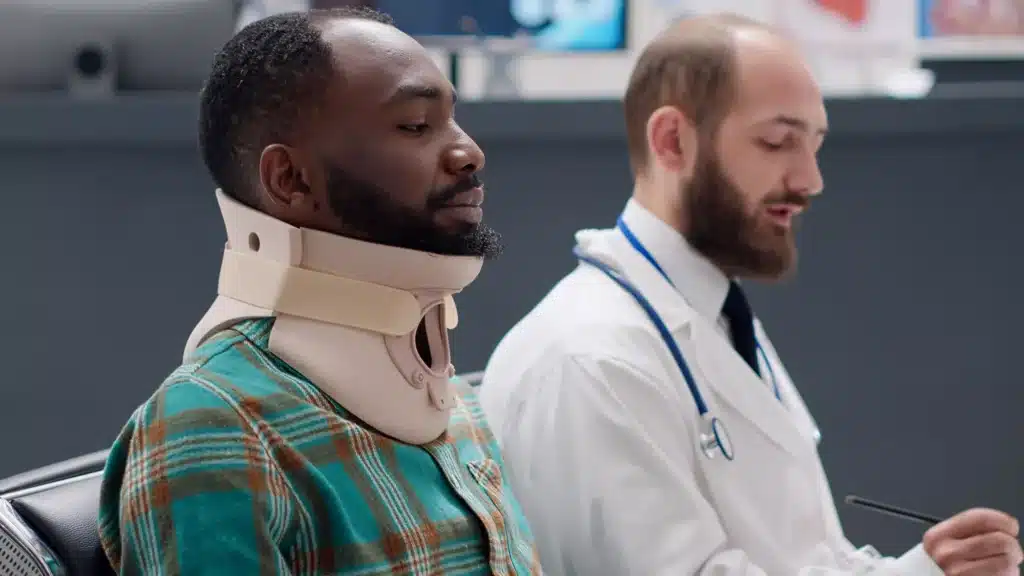
Table of Contents
ToggleSpine surgery through the front of my neck? Let us explain…
To treat neck pain and stiffness caused by herniated discs, your surgeon will perform a procedure called Anterior Cervical Discectomy and Fusion.
During this surgery you’ll be put under general anesthesia or given a spinal block through the front of your neck to numb the area; during this time surgeons cut out part of one or more cervical vertebrae in order to relieve pressure on pinched nerves.
ACDF is a surgical procedure used to treat neck and back pain caused by a herniated disc.
During ACDF, the surgeon removes the portion of the disc that has ruptured (herniated), then places bone grafts in its place—to alleviate strain on surrounding nerves.
ACDF can be performed through an incision in front of the neck (anterior), or through an incision at the base of your skull (posterior).

The incision is made in front of the neck, and it’s hidden by your hair. The incision will be on the left side of your neck, below your jawline.
The surgeon will make an incision between the chin and earlobe so that they can access all vertebrae in this area (seven cervical vertebrae).
The surgery involves removing disc material that has been pressing against spinal nerves, resulting in pain and weakness throughout parts of your body such as arms or legs.
If necessary, bone spurs are also removed so that there’s enough space for new tissue to grow back together after surgery–this process is called fusion or arthrodesis.
Bone graft comes from either the patient, or from a donor. In some cases, both are used: one for the front of your neck and another to fill in gaps at other points on your spine.
The bone graft is attached to vertebrae by titanium screws (small devices made of metal). As time passes and healing occurs, this material grows into place and fuses together all four vertebrae into one solid structure again–making it possible for you to regain your normal range of motion without pain or risk of further injury.

The goal of this surgery is to relieve pressure on the spinal cord or nerve roots caused by a bulging disc and also to remove the disc and fuse the vertebrae together so that there is no movement between them.
This can help prevent further damage to your spine if you have an unstable disc that has herniated or slipped out of place.
If you have been told that you need to undergo surgery, it is important for you to know what type of procedure will be done on your neck—as well as its risks and benefits—before deciding whether or not the operation should go ahead.
Once the disc is removed, the surgeon attaches a cage to hold the two vertebrae together while they heal naturally over time. The cage is made of metal and attached to the vertebrae with screws or rods.
This will help keep your spine straight while it heals so that you can avoid future pain.
Once your bones have fused together sufficiently (this usually takes about six months), your doctor will remove this “internal scaffold” as part of a follow-up surgery called an anterior cervical discectomy and fusion removal (ACDF).
Your neck will be placed in a brace for four to six weeks. This is to ensure that you don’t move your head or neck, which may cause further injury.
For the first few days after surgery, you will have some pain and stiffness as well as some difficulty sleeping due to muscle spasms.
As time passes and healing progresses, these symptoms will subside but may return if there are any setbacks during recovery or if you do too much too soon (for example: lifting something heavy).
The best thing for you is patience! You should not resume normal activities for at least six weeks after surgery; even then, it’s important not only that you listen carefully when your doctor gives advice on what kinds of physical activity are safe but also that he or she evaluates how well those recommendations worked out over time (i.e., did they keep me healthy?).
In general terms:
An ACDF is a complex procedure that requires careful planning and preparation. The recovery process can be challenging, but it’s important to remember that every patient is different.
The best way to know what your experience will be like is by talking with your doctor about all of the options available so that together they can create an individualized treatment plan for you!
GET IN TOUCH +
285 Sills Road
Building 5-6, Suite E
East Patchogue, NY 11772
(631) 475-5511
184 N. Belle Mead Road
East Setauket, NY 11733
(631) 675-6226
GET IN TOUCH +
285 Sills Road
Building 5-6, Suite E
East Patchogue, NY 11772
(631) 475-5511
184 N. Belle Mead Road
East Setauket, NY 11733
(631) 675-6226
SUBSCRIBE TO OUR NEWSLETTER +
Send us a Google review. Click this link and let us know how we did!
Review us on Yelp too.